
Incorporating Fire Safety in the Design Phase of Mixed Use Buildings
Looking for more information?
Contact our team
In this blog by Peter Stephenson, we take a look at incorporating fire safety in the design phase of mixed-use buildings.
Peter also considers the fire safety considerations required during the construction phase, and the ongoing fire protection measures required during the building’s occupied life.
What are Mixed-use Buildings?
Mixed-use, or complex buildings, are typically larger buildings that will be occupied in numerous ways. This may include shopping centres that have retail outlets, food and drink establishments, underground parking, and various entertainment areas such as cinemas. Other mixed-use buildings include transportation hubs (airports and railway stations etc.) office buildings with lower level retail outlets, or residential buildings with office or retail space.
When designing the fire safety for mixed-use buildings, every end use must be considered. The order of movement is crucial as not every occupier may need to evacuate in every circumstance, and therefore the notification and alarm systems vary by occupation zone.
This is where experienced consultants can bring value to the project. Fire consultants have specific expertise in the area, extensive knowledge of building codes and regulations, and technical modelling capabilities to determine the potential passage of heat and smoke and the ability to assess and determine the optimal evacuation routes and management plans.
The creation of a complete fire strategy at the design phase provides an overall outlook at all scenarios where fire can affect a building and its occupiers, and prevents any of these common mistakes from impacting the construction phase. It is a key component in every building design and can save time and costs in the long run, and most importantly, can save lives.
Construction and Phased Occupation of Mixed-use Buildings
The fire safety measures of mixed-use buildings require additional thought during the construction phase. Not only do all systems need to be correctly installed to protect the building structure and human life during occupation and escape, but special consideration needs to be incorporated where there is a client requirement for partial occupation while construction carries on.
As with the design phase, expert consultants can play a vital role during construction. These consultants can advise on not only the correct procedures and implementation of the fire strategy, but they are often part of third-party testing and certification bodies as well.
Product certification assures that the fire performance result of the product that was tested, is repeatable if installed in exactly the same way as the tested and certified sample. The use of properly certified products is a generally accepted and adopted practice, however, many contractors misunderstand that properly certified products are not enough to satisfy compliance with the building codes. They may not appreciate the need for the correct installation in accordance with the certification listing and approved design, which, if done incorrectly, could deem the product or system’s fire performance entirely ineffective.
Site inspection can be done in existing premises or on construction sites in one day, over the course of several days, or on an ongoing basis, depending on what is required. Safety should be at the heart of every building’s lifecycle and testing and certification are key components in ensuring the safety and protection of the lives of all occupiers.
Occupation of Mixed-use Buildings
Ideally, the longest phase of a building’s lifecycle is its occupation. Apart from ensuring the fire safety systems, including sprinkler and alarm systems, are in working order, many people don’t consider the longer term fire protection measures that need to be upheld. This is especially true in mixed-use buildings, where we often see renovations or refurbishments to various outlets and spaces, which introduces fire risk associated with construction activities.
Maintenance and monitoring of fire safety systems is crucial and people with the responsibility for fire safety must be competent in their role and empowered to rectify any identified issues within their remit. With this in mind, it is essential to consider the fire strategy we discussed in the design phase as a living document, which continues to outline requirements and responsibilities. All fire strategies should outline the fire protection measures provided and state the standard to which regular third-party testing and maintenance should be undertaken. In complex buildings in particular, attention should be paid to making any changes that might disconnect the cause and effect of existing measures, which may in turn compromise escape routes and the overall safety profile within the premises.
Fire safety should not something that should be taken lightly. Businesses of all kinds, across multiple industries and countries, strive to find value for money and efficiencies, but correct, complete and compliant fire protection is not something that should ever be compromised.
Warringtonfire can undertake the full service offering across testing, inspection, advisory and certification and can discuss any requirements you may have. We understand the true importance of fire safety and inspections and we are passionate about sharing this message. Contact us for more information.
Find related Resources